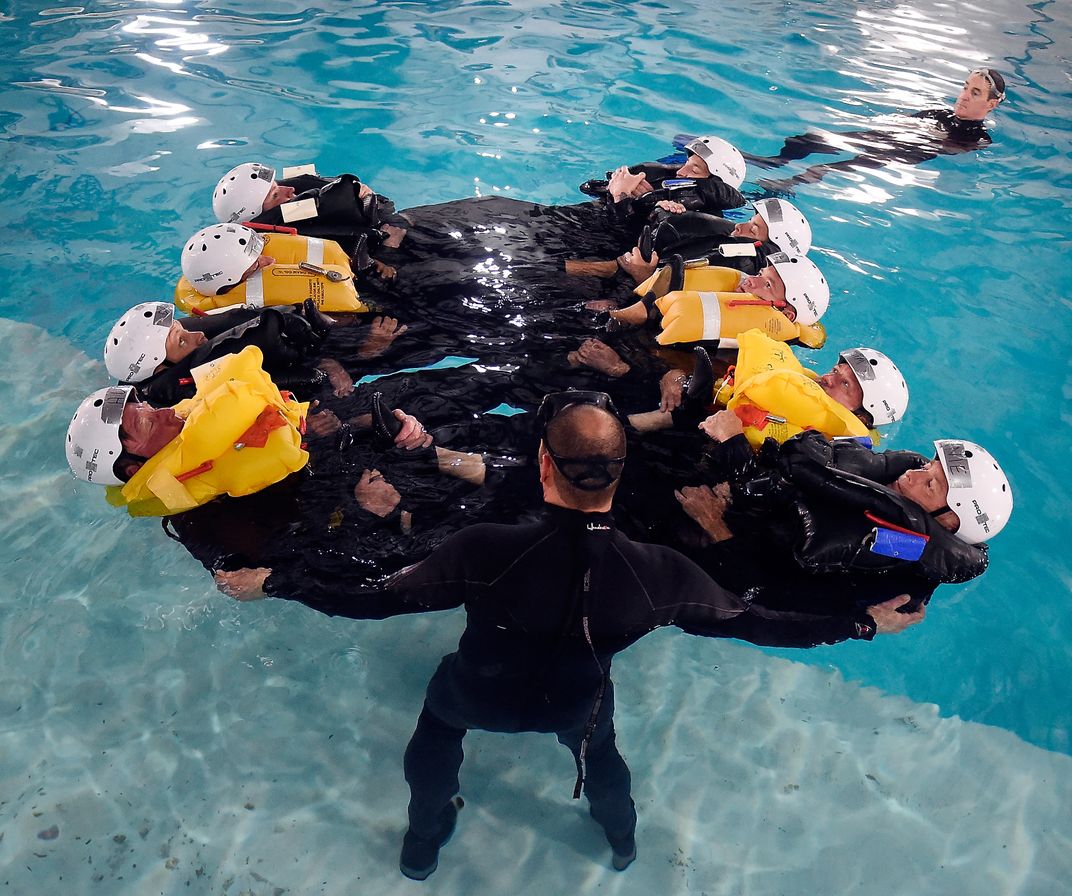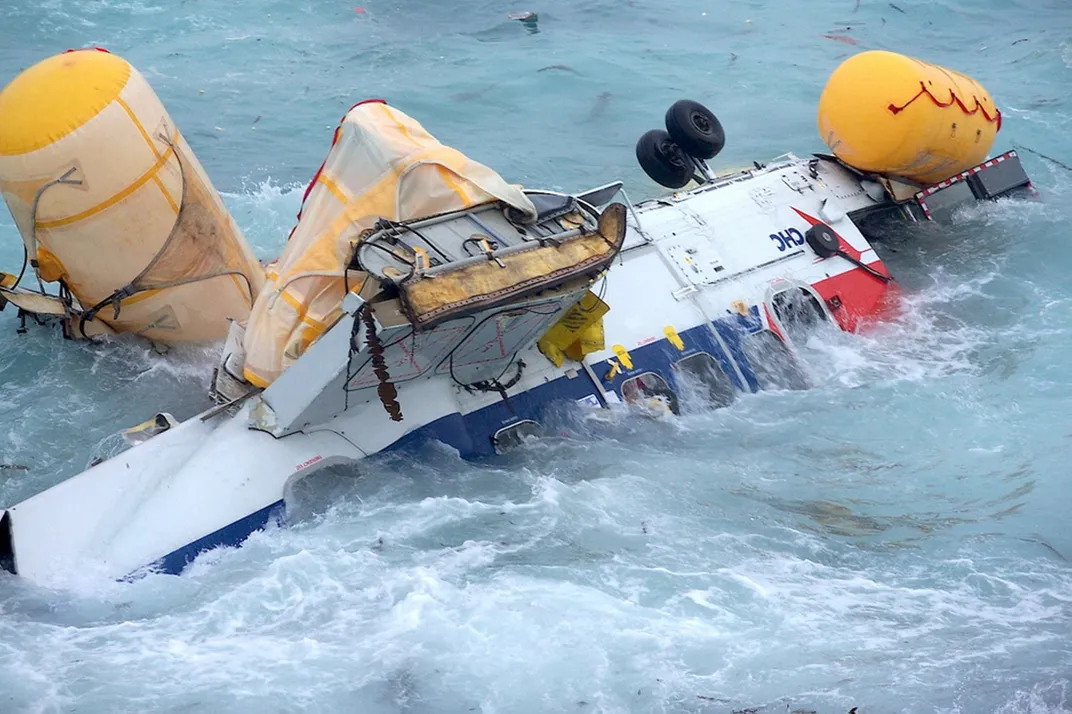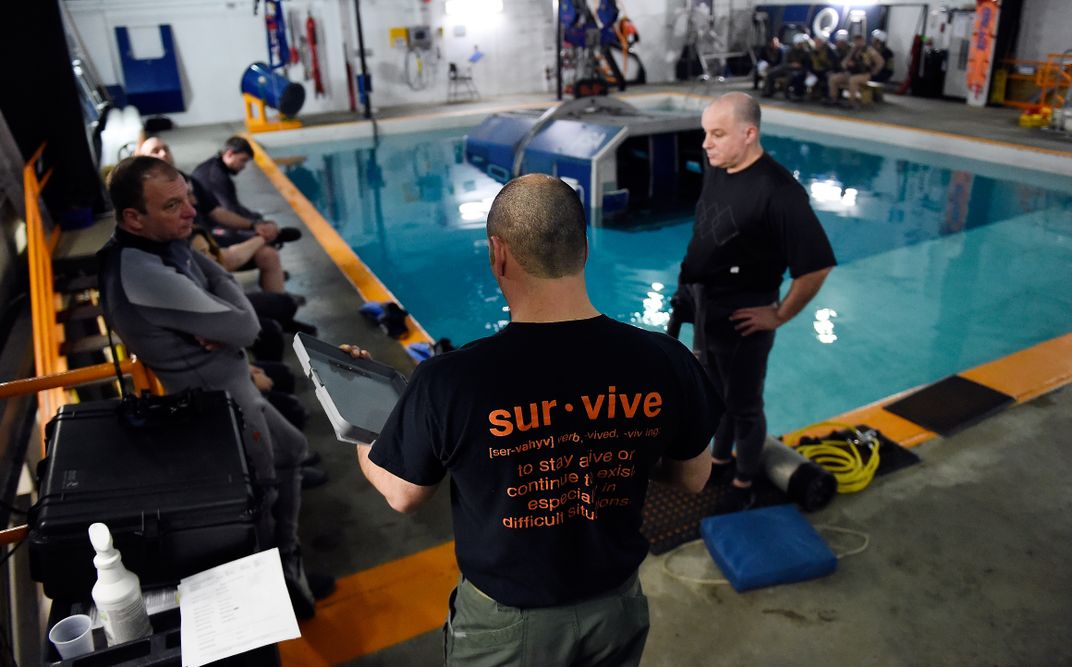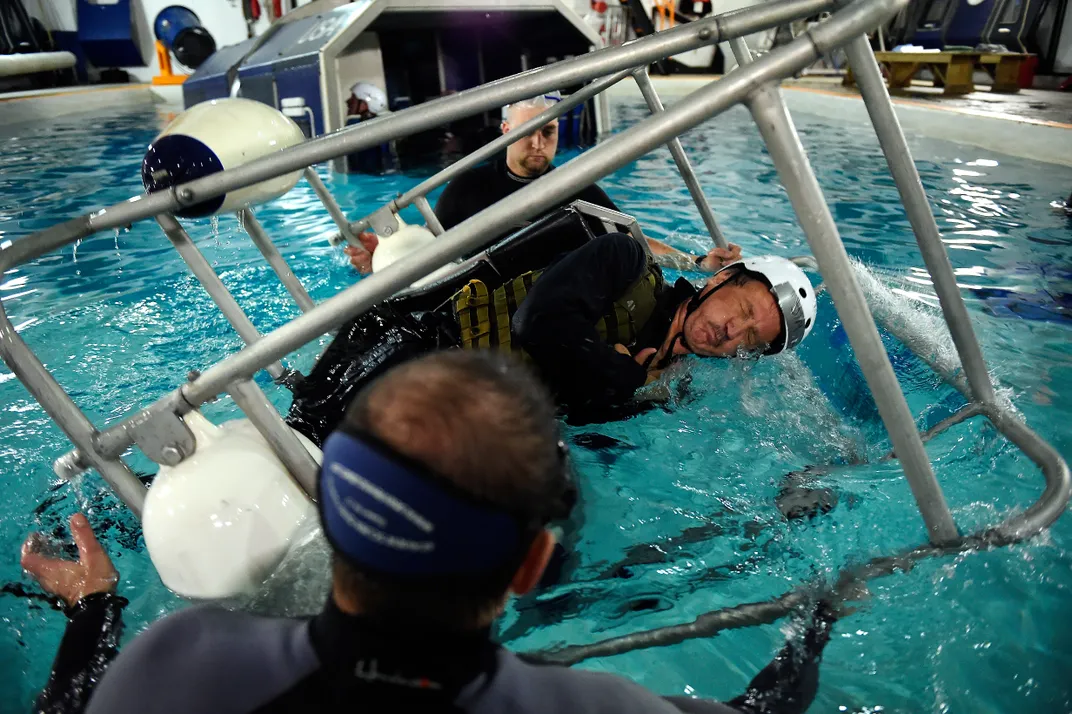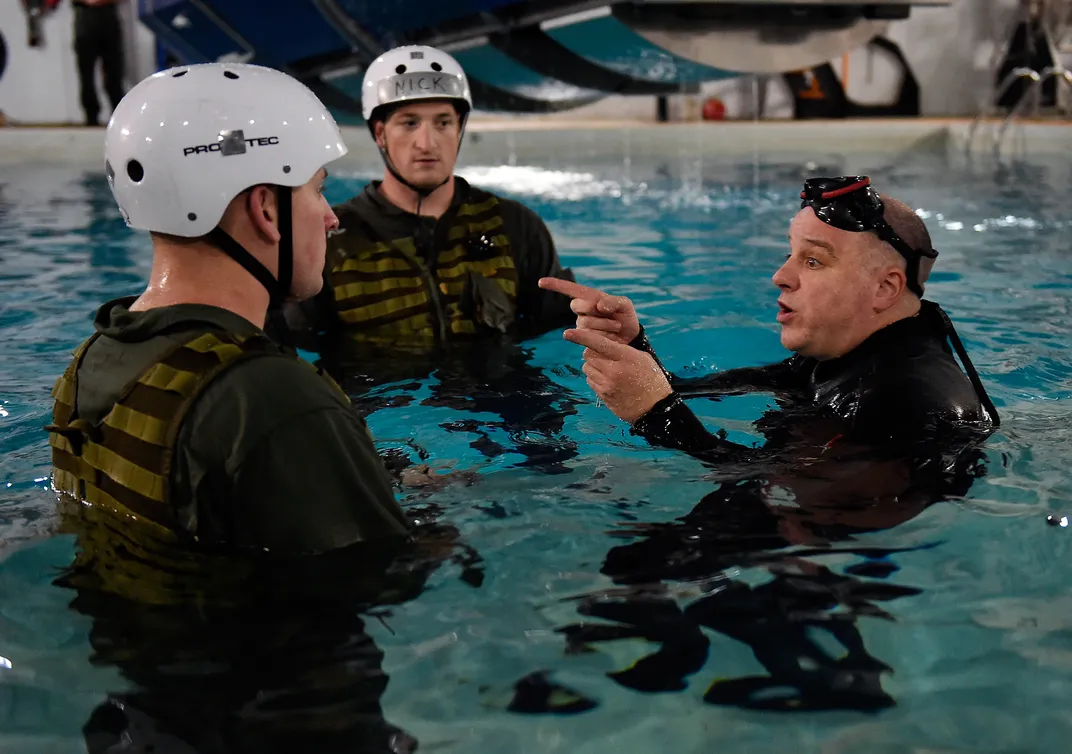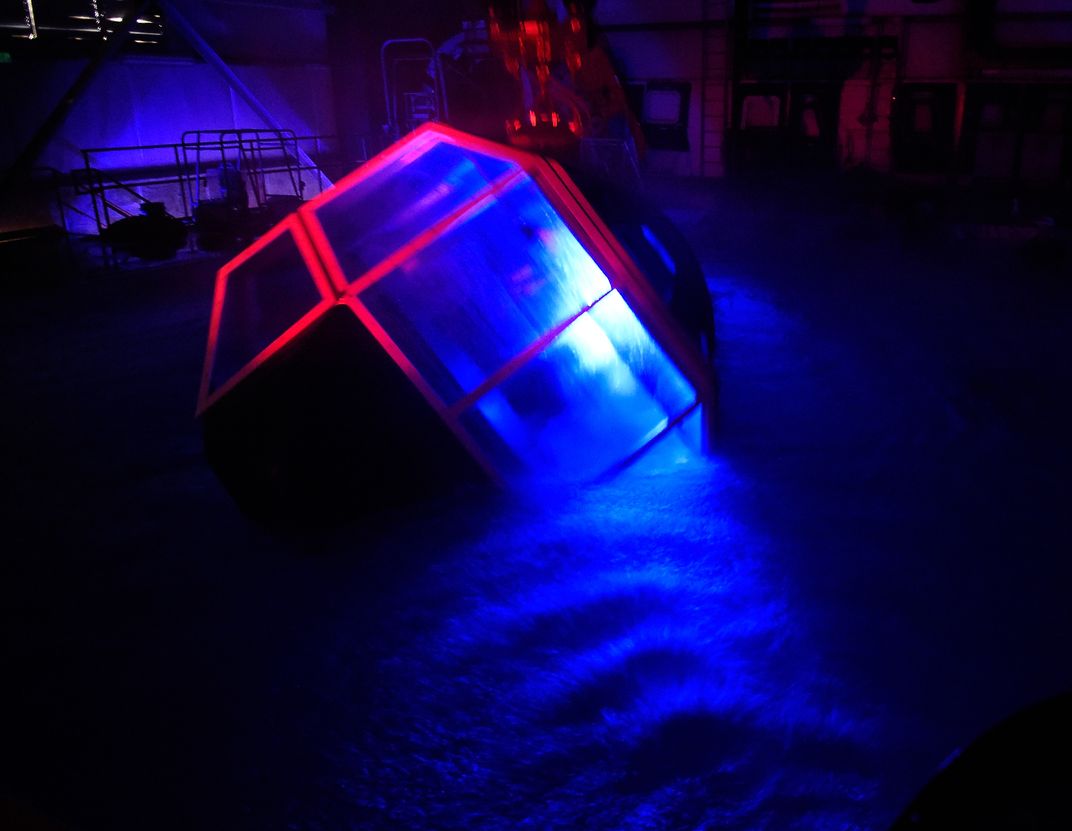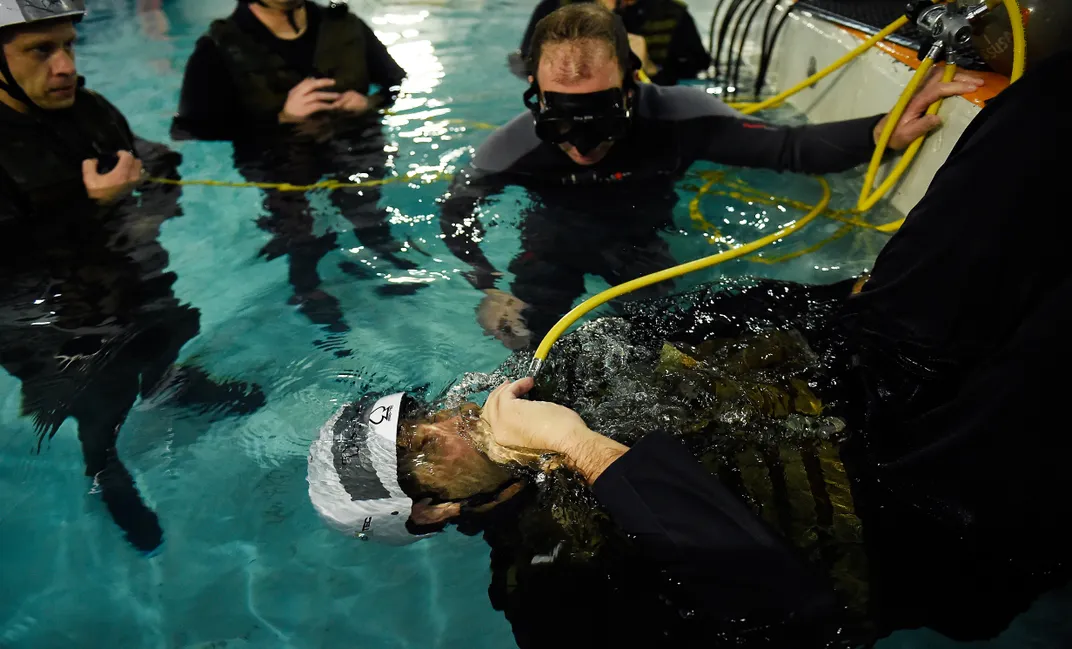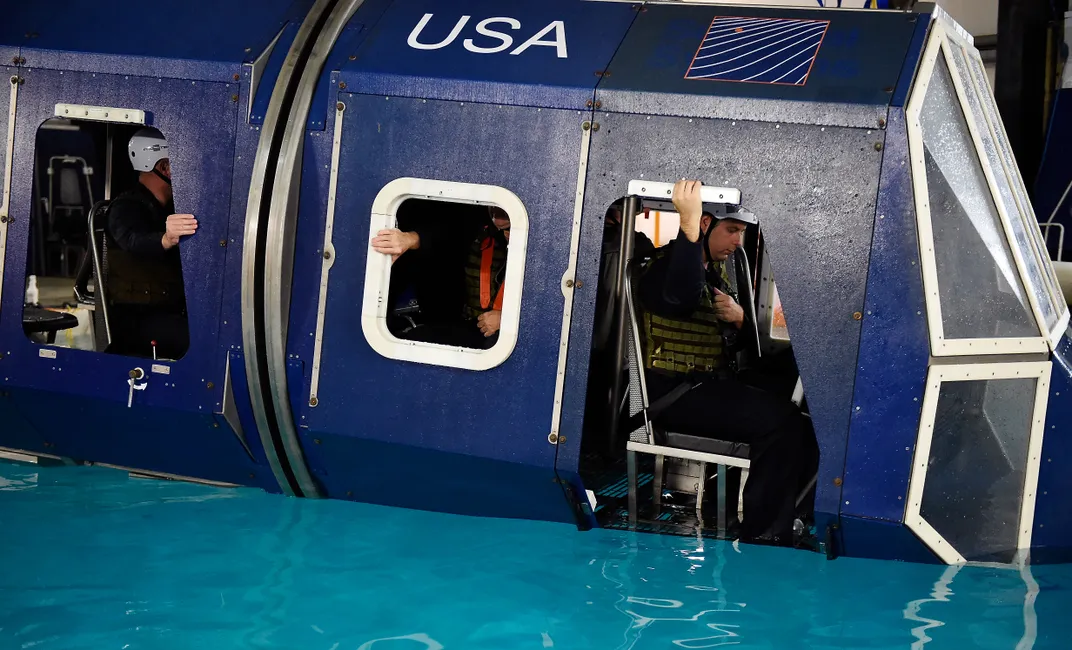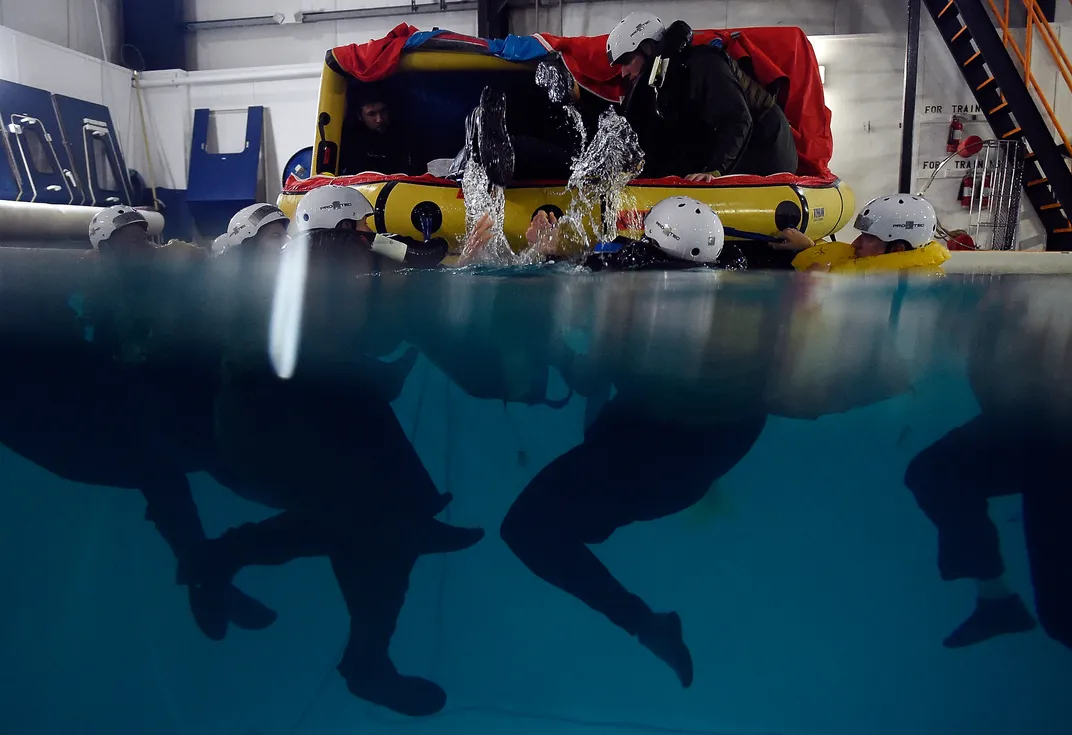How to Survive A Helicopter Crash
Specialized—and terrifying—training helps passengers prepare for the worst.
:focal(513x261:514x262)/https://tf-cmsv2-smithsonianmag-media.s3.amazonaws.com/filer/fe/8f/fe8f7c89-f43b-4613-888c-3bd94dc9e8b7/helicopter-water-training-1100.jpg)
It’s dark inside the half-submerged structure as my classmates and I follow instructors Ben Rayner and Shane Lucas into the gloom to pick our seats in this simulated UH-60 Black Hawk helicopter cabin. We’re wearing flightsuits, helmets, vests, and pool shoes.
We’ve been advised that the underwater-escape problems will ratchet up in difficulty, to the point where we’ll be flipped upside down, in darkness, and dealing with obstacles on the way out, but Rayner has also assured us that nobody’s going to drown during this helicopter underwater-egress training.
Survival Systems USA offers several such courses at its headquarters building alongside the airport at Groton, Connecticut. The one-day course teaches the basics of escape from a flooded aircraft cabin on “breath-hold,” meaning without the help of emergency breathing gear. It’s chiefly for civilians who fly over water in small aircraft, such as business jets, floatplanes, air taxis, or air-ambulance helicopters.
I’m taking the two-day course, called Dunker Training. It’s designed for crews who train to military or law-enforcement standards. It adds two main topics to the short course: how to survive once out of the aircraft, and how to use a mini-SCUBA set that fits in a vest. The pressurized breathing gear poses some risk of injury or death—even to students in class—but offers valuable time when escape proves difficult. And underwater escape is a field where small margins, plus a powerful will to see one’s family again, make all the difference.
Along with Rayner and Lucas on the inside of the cabin, two SCUBA divers will be on the outside, watching our group of four students for signs of distress. Lucas and Rayner can release seat-belt straps in a hurry, and can signal the crane operator to haul the cabin out of the water. If the crane’s power supply were to fail at that instant, the crane has an emergency pneumatic air supply. But it’s not a free pass: If an instructor has to intervene, say by dragging us to the surface, we’ll have to rinse and repeat before moving to the next challenge. Unlike some underwater egress training schools, Survival Systems instructors don’t offer students any time-out signal to wave for help during the runs. I’m told that since real crashes don’t offer time-outs, depending on them is a bad habit to acquire during training.
Earlier, Rayner told us to pay attention to whoever is shouting the loudest, and he meets that test easily. Compact, energetic, with short gray hair, he’s an experienced diver and reminds our class that when navigating around the cabin, we should rely on hands and memory, not eyesight. A real crash could happen at night, or the cabin could be murky with floating debris, or leaking fuel and hydraulic fluid could blind us. Emergency lights are no guarantee of clear vision either: Those, along with a curtain of bubbles from the sinking aircraft, can obscure the exits. “So it’s best if you keep your eyes closed underwater,” Rayner says. “If they’re open, you just get bad data.”
It’s time to make a seating selection; each student gets an entire row of seats to himself, unlike any other setting in modern aviation. The Black Hawk layout offers three rows of seats, and I select the row behind the flight deck, taking a side-gunner’s chair.
The empty seats are an anti-panic measure, one of many lessons from a half-century of underwater-escape training (the Royal Navy began tormenting air crews with the training in 1962; the U.S. Navy, 10 years later). In the early years, some exercises filled the cabin with students. That was highly realistic but also dangerous because anxious students piled up at the exits. Another safety upgrade: After a few deaths in the early years, schools now screen students for any ailments that might be aggravated by near-drowning experiences.
At least a quarter-million people have passed through helicopter escape schools worldwide, mostly as part of offshore-oil employment. The degree of realism (and stress level) varies from school to school, as does the equipment. Why the focus on rotorcraft? Helicopters fly lower and slower than airliners, so when they hit the water, their cabins are usually intact enough to trap people inside. And because the heavy machinery (engines, transmission, and main rotor) is up high, helicopters tend to roll over quickly.
Over five decades, dozens of military and oil field transports have crashed in the water with passengers, and of the deaths that resulted, drowning has been a common cause. In one eight-year span, two big transport helicopters crashed into English waters, killing 74.
Helicopter-escape lessons are relevant for anybody at risk of being trapped in a vehicle that tumbles into the drink and floods quickly, whether that’s a pontoon-equipped airplane or a military vehicle operating close to canals in the Middle East. Singer Jimmy Buffett was piloting a floatplane off Nantucket Island in 1994 when it hit a wave and flipped. He attributes his survival to underwater-escape training he’d taken at a Navy base.
Survival Systems’ dunker course ranks as one of the most realistic anywhere. While some offshore workers might say a better description is “one of the scariest,” the training has its selling points. Where else can a civilian train to the same standards as SEAL teams, Night Stalker crews, and Army Rangers? To train alongside combat troops, FBI agents, and even rock stars? David Lee Roth can be seen in one snapshot along a hallway of graduates. Roth trained here as a New York City paramedic while taking a pause from his career as front-man for Van Halen.
“The course gives confidence and skills to respond to horrific circumstances,” says Chris Judah, executive director at Survival Systems, as we talk in the front offices beforehand. “We want to avoid chaotic responses. Two or three seconds of panic can kill, but one or two seconds of thinking can save you.”
Quelling panic requires realistic training beforehand, adds Maria C. Hanna, president and CEO of the employee-owned company. “We make the simulation as real as possible without actually taking an aircraft out and ditching it. We can add an auxiliary fuel tank in the cabin—all kinds of obstacles.” Obstacles, darkness, and disorientation are part of the real world, she says: “You can’t assume you’ll always be seated next to an emergency exit.” To add to the realism, instructors can simulate different makes and models of aircraft by picking different cabin sizes, interior equipment, exits, and doors.
While the Navy, Air Force, and Army aviation house their own schools for underwater-escape training, the core classes there are the same as we’ll encounter at Groton, and this company provides all of the instructors for the Army underwater-escape training centers. A Canadian sister company of Survival Systems provides all of the equipment.
The company cites a graduation rate of 98 percent, and among those graduates are people who can’t swim and even some who arrive with an acute fear of open water. Hanna says the school builds skill and confidence—and holds panic at bay—with a crawl-walk-run approach.
That’s why on the first day our pool time starts not with entrapment in the simulated helicopter cabin, which can trigger claustrophobia, but by climbing into a floating metal framework holding a seat and harness. It’s called the SWET chair, short for Shallow Water Egress Trainer. Each of us is to be flipped head-down in the water by a pair of instructors so we can demonstrate Escapology 101: identifying our exit path, pushing out a panel, grasping the exit pathway with one hand while opening the buckle of the seat harness with the other, and pulling ourselves free.
When it’s my turn I climb into the open framework, and realize that this won’t be easy when even fastening my seat belt proves a challenge: It’s military style, with seat and shoulder straps that meet in a buckle with a rotating release. The four-point harness provides better protection in a crash than a car’s recoil belt.
Instructors provide no nose clips and I need both hands to escape, so as soon as I’m flipped over water rushes into my nose. For some people that feels a lot like drowning or being water-boarded, so instructors watch for signs of panic underwater: hands motioning jerkily, or eyes wide open in a look of horror. Panic following a helicopter crash can cause passengers to release their seat belts too early, leading them to float free and lose track of where the exits are. Or panic can block people from acting at all: “freezing in place,” the instructors call it. (Explaining the no-nose-clip policy, marketing director Hugh Teel says: “You wouldn’t be able to find nose clips in a crash, so you’d better not rely on them.”)
After a few runs in the SWET chair, it’s time for the helicopter cabin, which Survival Systems calls the METS (Modular Egress Training System). It’s a setting sure to dial up the fear factor. We’re to carry out each run on breath-hold only; work with emergency compressed-air tanks will come tomorrow. Barring mishap, no run should take longer than 20 seconds. Even though this is well within the average person’s breath-holding ability, Rayner reminds us to waste no time: “As soon as the violent motion stops, sit up immediately, locate your exit, and get moving. You’re not doing crossword puzzles down there!”
Rayner says that the UH-60 Black Hawk doesn’t float. Within seconds of impact the helicopter will be upside down, flooded, and heading for the bottom, sinking at a rate of nine to 13 feet per second. And that’s relevant today because five of the students in my class fly Black Hawks for the Delaware National Guard.
Also in our class of eight are two pilots for a federal civilian agency, who ask not to be identified. One of those I’ll call Tom. Tom has loads of experience in fixed-wing and rotary-wing aircraft. Currently he lives abroad. Tom’s father flew helicopters for the Marines in Vietnam. Tom is a colonel in the Marine Reserves; this is a refresher course for him, and he’s showing no signs of stress.
But I am, and as the first escape run in the cabin is about to begin, I appreciate the fact that Rayner and Lucas will be inside and watching our backs. They move through the cabin, checking our seat belts and brace positions. Lucas asks me to show my “reference point,” a method in which you rely on a body part like a knee or hip to serve as a landmark to find a nearby exit handle.
Satisfied that we’re as ready as we’ll ever be, Rayner calls to an operator at a control board. The fun begins with a distress call over the loudspeakers, then the word “Ditching” repeated three times. That’s our signal to take one last breath before the dunker plunges into the water and rolls over, leaving us upside-down and underwater in our seats. There’s an instant of panic—an urge to fight for air and grab onto something—but the water calms and the training kicks in.
The first run is a simple confidence builder, with all exits open: I use one hand to locate the frame of the gunner’s exit window, then use the other hand to release the seat belt, and leave hand over hand. The next run starts with that exit closed, so I have to push it out on the way.
Now it’s time for cross-cabin runs, simulating the possibility that the closest exit window could be jammed by the crash and we’d have to find another. I’m to abandon the exit by my seat, unbuckle, cross to the opposite side of the cabin, and find another exit, which will be open. Shane Lucas is on hand to tell me how to move crabwise, sliding from seat to seat, feet on the deck, never letting go of all reference points.
Next time, the cross-cabin exit is closed, so I have to open it. And that’s not enough for Lucas, who shifts me to a new row with more complicated exit mechanisms. And so it goes: One time, I find myself groping desperately for an exit handle, wondering how long I can stay down here, until I remember that it was diabolically (and realistically) tucked into a pocket in the door. That experience leaves me with small but vivid bruises on thumbs and fingers: Now I understand Rayner’s stories about hand injuries in reports of drowning deaths in confined spaces.
A student who finds the training too similar to drowning can ask for one-on-one instruction off to the side, or can take a rain check and come back later. And one student in our group takes that option; he’ll return another day. But there are no exemptions for anxiety; the escape certificate requires completion of all runs, and many employers and military branches won’t let people fly on water-crossing helicopters without the certificate.
Ever since a crash off the deck of a Royal Navy carrier in 1958 drowned a squadron commander and brought the underwater-escape problem to official attention, experience has shown that training increases the odds of survival. Consider the flight of a Super Puma helicopter over the North Sea on the afternoon of August 23, 2013. The Super Puma is a large transport commonly used to move workers between oil rigs and the shore, and on this day it was carrying 16 of them from the Borgsten Dolphin platform to an airport at Sumburgh, Scotland. Just two miles from the runway, the helicopter started behaving erratically and slammed into the ocean. In seconds the aircraft flooded with frigid water and turned upside down.
Three passengers drowned inside the cabin, and a fourth was found dead outside. It was the 25th offshore helicopter mishap in the United Kingdom since 1992, and the fifth in the last five years. In arguing for stricter safety standards—some of which will take effect in the coming year—an official from the pilots’ union told reporters: “We believe something is wrong in the North Sea.”
Or perhaps in all seven seas, now that so many nations are developing offshore oil fields far over the horizon, and depending greatly on helicopters to move them around. While the risk may seem small to a statistician—about two fatal crashes per 100,000 flight hours—it’s much higher than the risk to airline passengers, and it falls heavily on a small group of regular users. That group is increasingly wary. A Russian-built Mi-17 filled with oil workers crashed off India in 2003, leaving only three alive. In 2005, a Sikorsky transport crashed off Talinn, Estonia, killing everyone. In 2009, a larger Sikorsky transport ditched in the north Atlantic off Canada, leaving passenger Robert Decker as sole survivor.
Nothing substitutes for safer helicopters, Decker told a Canadian inquiry later: “Safety starts with the helicopter, and I think everything else is secondary.” He attributed his survival chiefly to good luck, good physical condition, and long experience sailing in cold waters.
“We try to take luck out of the equation,” Rayner tells our group. And that means repetition. In one run in the dunker, I lose my bearings, and Lucas reminds me to pause and go back to my reference points. And then if I can’t locate the exit with my free hand, he says, chances are that I’m not using a full-arm sweep. “We see it all the time,” he says. “When students get worried and start reaching around, hunting for an exit handle, they only use a half-gesture.”
On the final run, instructors add rotor noise and hurricane winds from a giant fan machine, and douse the lights for good measure. Other audio effects in the Groton house of horrors include foghorns and gunfire. How are we to know which way is up in total darkness? The answer, in effect, is: “Use your heads!” Our helmets have a plastic foam lining, and their buoyancy will lead us up.
Four hours of class the next morning pass quickly enough, because, so say the instructors, our lives may depend on paying attention. We watch clips of fatal helicopter crashes into bodies of water large and small, even a swimming pool in Venezuela (cause: a firefighting chopper got its tail rotor tangled with a fence and lost control). One clip shows a CH-46 helicopter transport that crashed while approaching a carrier off Point Loma, California, in 1999. It was packed with Marines standing ready to drop by rope, as part of a maritime hostage-rescue exercise. After the helicopter went out of control, rolled over, and sank, seven of the Marines died.
Classes concentrate on how the equipment works, the importance of memorizing the cabin layout before takeoff, and how to handle contingencies that can’t be taught in the pool. (I start making a list of all possible mishaps; it fills five pages.) The overall goal, explained Chris Judah earlier, is that students leave with the ability to think clearly after the crash and work through problems as they arise. For that, more will be required than a “muscle memory” of standard operations, such as how to work the exit handles.
One simple drill that must be memorized is how to brace for helicopter impact. Pulling out a bucket seat with a military-standard four-point harness on the first day of class, Rayner had tightened the straps, then crossed his arms to grip a shoulder-belt in each hand. His arms left a sort of pocket over his chest, which he tucked his head into. “A copter crash slams you back and forth, so that can hurt your back, knees, feet, hands, arms, and neck,” he said. “But with a good brace, you can survive some really tremendous impacts.”
He waggled his thumbs to get our attention; they were pointed up, not locked around the shoulder straps in a classic fist. Only his fingers held the straps. This detail, he said, cuts the risk that a violent impact will dislocate our thumbs, and during escape, working thumbs are likely to be critical. Looking at the four pilots in our group, Rayner reminded them that during a crash, aircraft controls and dashboards cause grievous injuries, so a good brace position is no less important on the flight deck.
Repeatedly we’re warned during class and pool sessions that, however scary we might regard the exercises, a real crash is likely to be harsher: objects flying through the air, ice-cold water blasting as if from a fire hose, exits barely wide enough to squeeze through, shock-absorbing seats that collapse and trap one’s feet, and a cabin with more passengers than exits. An unpleasant surprise: According to Survival Systems, more than half of aircraft crashes happen with little or no warning to the passengers. After surviving the high-speed water impact of a Coast Guard H-60 Jayhawk that hit a power line off the Washington coast in 2010, Lieutenant Lance Leone recalled that “we were flying, everything was fine, and then it blew apart.”
As the second day of class winds up, instructor Dan McInnis reminds us for the umpteenth time that since we’ll be using an emergency SCUBA set called an Emergency Breathing Device, or EBD, there will be some extra rules stacked onto the afternoon’s work.
EBD is now standard for users of military and many public-safety helicopters. An EBD bottle fully charged with air offers more than a minute of underwater survival time, even several minutes. How much time depends greatly on one’s ability to take slow breaths. We’ve listened to an interview with a Royal Navy pilot who had to deal with a jammed window and entanglement on the way out of his helicopter: The EBD bottle gave him sufficient time to work things out, but had he panicked, it wouldn’t have been enough.
Before going into confined spaces with an EBD, there’s a mini-ordeal called “The Wall,” in which instructors hold us upside down against the side of the pool, while we pull the bottle and attached hose from our vests, clear the mouthpiece of water, and breathe. It’s a major selling point of the EBD that the user can be trapped underwater before he starts it up. Another device, a “re-breather” bag to scrub carbon dioxide from the user’s own breath, can’t be started while underwater. Nor does the re-breather offer as much survival time as an EBD set. And time is critical when evacuating a Super Puma underwater; one set of tests showed that even under good conditions a fully loaded aircraft took 90 seconds to clear when underwater; no passengers are going to hold their breath nearly that long in cold water.
An EBD improves escape chances near the surface, but it can be dangerous—even fatal—to users who forget to exhale on the way up. One of those risks is air embolism—air bubbles that go to the brain. Even a short dive going no deeper than 10 feet can leave the non-exhaler with stroke-like injuries.
So instructors constantly remind us to exhale on the way up, and they arrange exercises so that no student need go any deeper than four feet. But the pool is 14 feet deep, so mistakes are possible.
The pool’s depth and size once attracted a video crew, which hired the facility and its expertise to create an “underwater nightclub” set to promote its watches. Diver Fred Ward tells me that Survival Systems has gotten a range of entertainment-related requests, from hosting TV reality shows to engineering amusement park rides. I find the cabin dunker too stressful and risky for an amusement-park ride, though as the afternoon goes on, the challenges become slightly more fun than fearful.
One aspect of the second day’s training could qualify as an amusement park attraction, in terms of movie-style vividness. Instructors turn off the lights and simulate a helicopter rescue, using the crane to drop a “horse collar” rescue strop on a cable, as a helicopter’s winch would do. A cyclone-strength blast of air from above, along with full-bore rotor noise via loudspeakers, simulates what it feels like to have a Coast Guard helicopter looming overhead, turning night to day with a searchlight, kicking up chop, and blasting spray into our eyes. Each of us swim to a floating strop, roll into it, attach the free end to a hook, and get hoisted up. Normally a rescue swimmer would be on hand to assist, but as with all other drills here, the goal is to participate in one’s own rescue, rather than waiting helplessly for outside help.
How does this training play out in the real world, with actual and chaotic hazards? While it’s impossible to nail down an exact figure, underwater escape training is likely to double or even triple the odds of getting out from a ditching or a “survivable” crash, meaning a mishap that leaves the occupants alive but stuck inside a flooding cabin. And survival will also depend on having the right equipment, such as the insulated suits that North Sea passengers wear to cope with cold-water immersion.
Patrik Nilsson, a Swedish rescue swimmer, credits escape training as one reason he and his four fellow crew members survived when their helicopter crashed into the waters off of Sweden in September 2004. And it was a close thing: When the aircraft hit the water and flipped, the men in back had no warning. It was night, and two of them were out of their seat belts at the time, preparing to pick up a cardiac patient from an island nearby. One of those was Nilsson; he oriented himself underwater, helped a crew member, and got out without using his EBD bottle.
“[Underwater escape] training is important not only for yourself,” Nilsson says in an email. “You may need to help a colleague. You should certainly not be a burden to other crew.”
In the final gathering, as we received our dunker diplomas, Hugh Teel, sales manager for Survival Systems, summarized the training this way: “When you go home, now you’ve got a fighting chance. It’s not a guarantee, but a fighting chance.”
And one more thing: Now we know what it’s like to slip the surly bonds of a sinking aircraft, then float freely upward, and breathe in open air. It’s a marvelous feeling.
